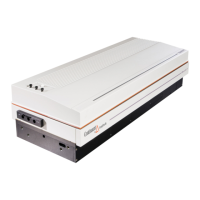Precision II Operation and Maintenance Manual C
5-18
996-0255 rev. b
free-running pulse
starts to free-run
flashlamp rise
“active” free-running. Active free-running is generally caused by ther-
mal blooming effects in the Pockels cell.
Warning!
Operating the Q-switch while the laser is free-running can
cause severe damage.
During normal laser operation free-running will manifest itself in the
form of erratic shot-to-shot stability or even a snapping sound coming
from the laser. If this occurs, stop the Q-switching immediately and
follow the next procedure to eliminate the problem.
The following is a procedure to check for and eliminate free-running:
All optical adjustments should be made in the passive (not Q-
switched) mode.
1) Place a beam block after the first turning mirror ( 7c) to
block the oscillator beam.
2) Place a photodiode so that light scattered off of the beam
block can be monitored.
3) Set up an oscilloscope (does not have to be a fast scope).
a. Connect photodiode to a 1MΩ input on the scope.
b. Run a trigger BNC from J4 connector (located on the
back of CB chassis) to the external trigger input on
the scope.
c. Set the time base to 100 µs.
4) Ensure that the power unit is set to the normal operating
voltage.
5) Start the laser (flashlamps firing only).
6) Adjust the photodiode so that it detects a small amount
of the flashlamp light and scope displays lamp discharge
curve.
flashlamp signal

